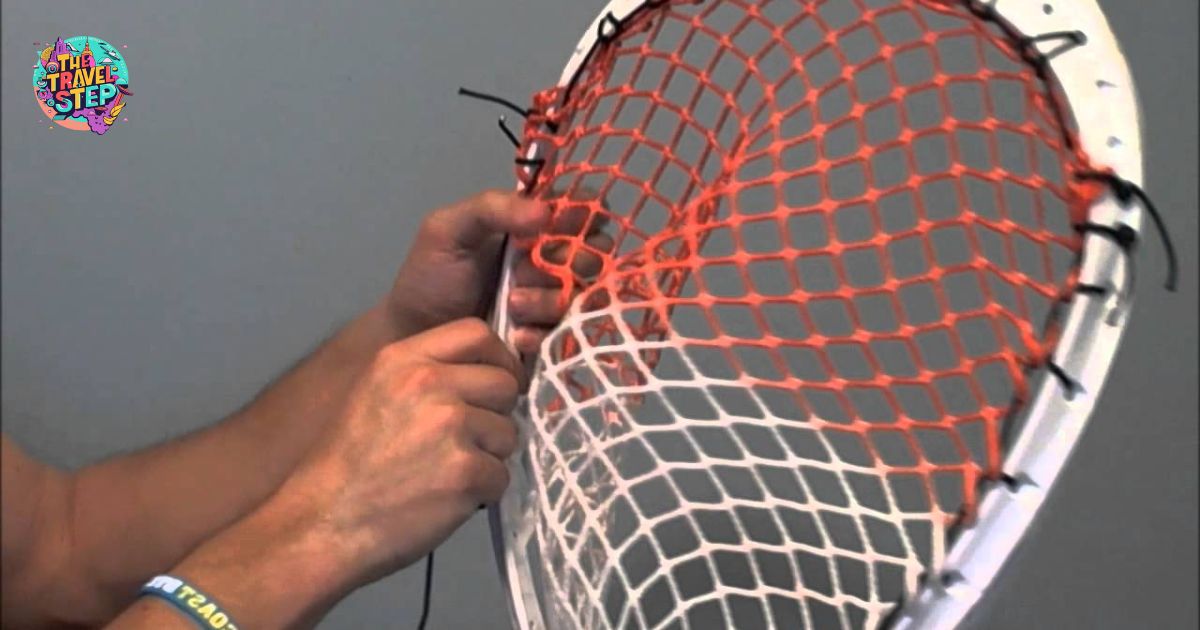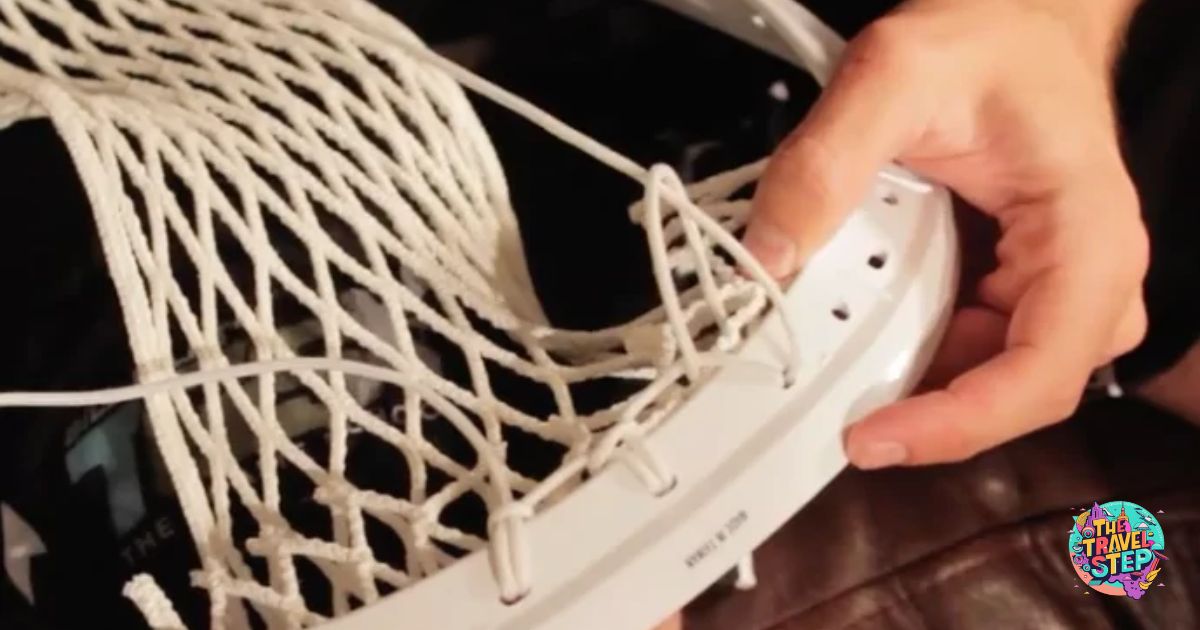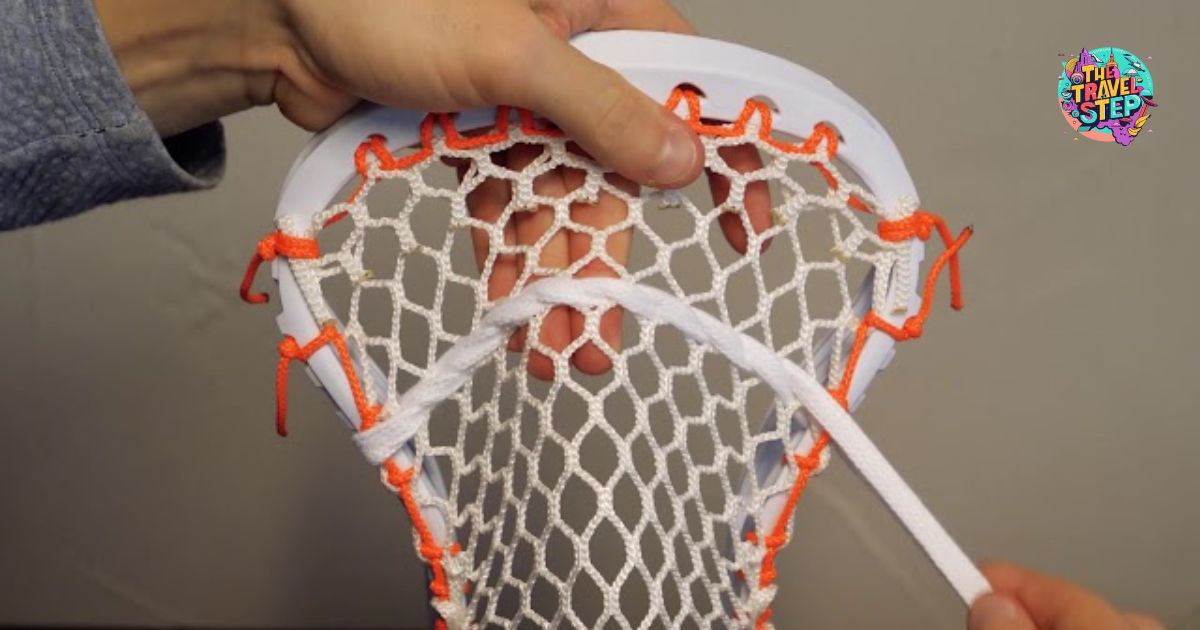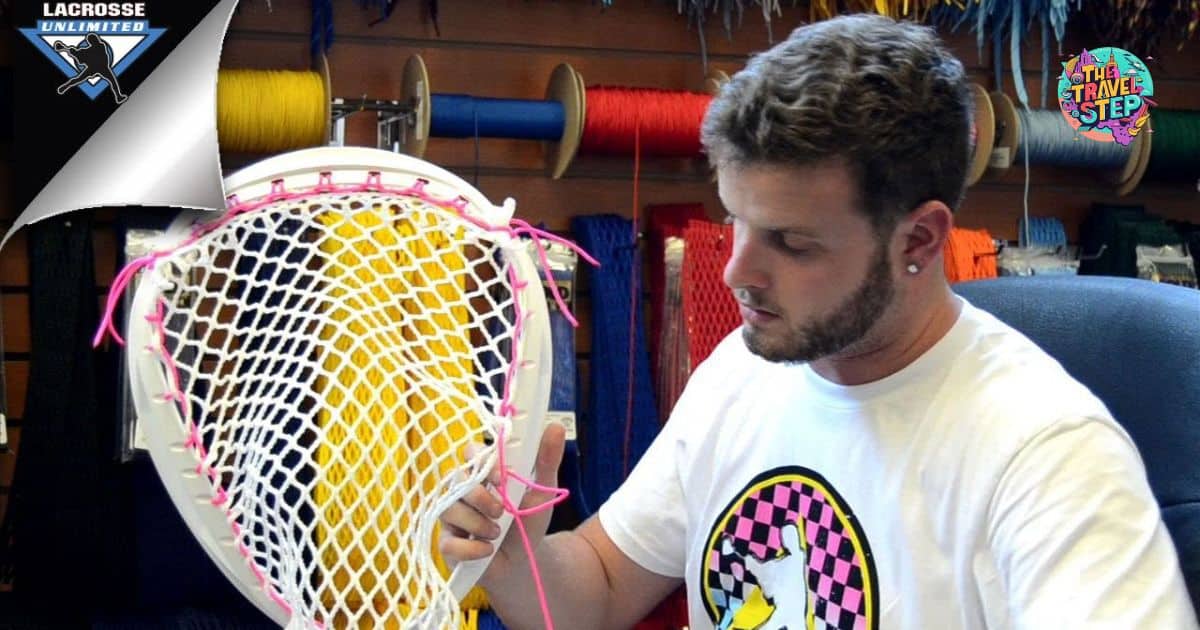Are you tired of struggling to string your lacrosse goalie head? Don’t worry, you’re not alone. Many lacrosse enthusiasts face this challenge. However, with the right guidance and techniques, you can become a master at stringing your goalie head. In this article, we will provide you with step-by-step instructions and valuable tips on how to achieve the perfect stringing for your lacrosse goalie head. Get ready to elevate your game and join a community of skilled lacrosse goalies.
Key Takeaways
- Gather all required materials and inspect the goalie head for defects before stringing
- Maintain consistent tension and properly place knots along the sidewalls for desired pocket depth
- Consider the placement and tension of strings for a reliable pocket and adjust the pocket’s release point for more control over saves
- Incorporate shooter strings for enhanced accuracy and power, using different types such as nylon, hockey lace, mesh, sidewall strings, or leather
Necessary Preparations
Before we begin, let’s discuss the necessary preparations for stringing a lacrosse goalie head. Stringing a goalie head requires attention to detail and precision to ensure optimal performance on the field. To start, gather all the required materials, including a goalie head, mesh, shooting strings, sidewall strings, and nylon strings. Make sure you have a sturdy stringing kit with a variety of strings and tools to assist you throughout the process.
Next, carefully inspect the goalie head for any defects or damage that may affect its functionality. It is essential to clean and stretch the mesh before stringing to ensure a consistent and reliable pocket. Finally, familiarize yourself with the specific rules and regulations set by your league or organization to ensure compliance. By taking these necessary preparations, you will be ready to string a lacrosse goalie head effectively and confidently.
Top String
To properly string a lacrosse goalie head, begin by securing the top string with a double knot. The top string plays a crucial role in the pocket formation and overall performance of the goalie head. It helps create a consistent release point for accurate passes and shots. To start, thread the string through the first sidewall hole and pull it tight.
Then, bring the string diagonally to the next sidewall hole and repeat the process until you reach the top of the head. After reaching the top, tie a double knot to secure the string in place. The top string should be tight enough to maintain the pocket shape while allowing for easy release of the ball.
Sidewalls
Continuing the stringing process, the sidewalls of the lacrosse goalie head must be carefully threaded to ensure optimal pocket formation and performance. Here are three important considerations when stringing the sidewalls:
- Tension: It is crucial to maintain consistent tension while threading the sidewalls. This will help create an even and balanced pocket, allowing the goalie to have better control over the ball.
- Knot placement: Properly placing knots along the sidewalls is essential for achieving the desired pocket depth. Strategic knot placement can also help in adjusting the pocket’s release point, giving the goalie more control over their saves.
- Sidewall material: Selecting the right sidewall material is important for durability and performance. High-quality sidewalls made from strong, weather-resistant materials can withstand the rigors of the game and maintain the pocket’s shape over time.
With the sidewalls properly threaded, the next step is to focus on creating the pocket.
After carefully threading the sidewalls, the next step in stringing a lacrosse goalie head involves creating the pocket. The pocket is the area of the head where the ball sits and is crucial for a goalie’s performance. To create a reliable and consistent pocket, it is important to consider the placement and tension of the strings. Here is a table that outlines the recommended stringing pattern for the pocket:
| String | Location |
|---|---|
| Topstring | Between the top sidewall holes |
| Sidewall string | Along the sidewalls, connecting the top and bottom holes |
| Shooting string | Across the top of the head, creating a channel |
| Bottom string | Along the bottom sidewall holes |
Bottom String
The next step in stringing a lacrosse goalie head involves attaching the bottom string, which plays a crucial role in stabilizing the pocket and providing consistent ball release. The bottom string is responsible for creating the depth and shape of the pocket, allowing the goalie to have better control over the ball during saves. Here are three important things to consider when stringing the bottom string:
- Position: The bottom string should be placed about 1-1.5 inches above the bottom of the head. This ensures that the pocket is deep enough to hold the ball securely, while still allowing for a quick and accurate release.
- Tension: The bottom string should be pulled tight to create a firm pocket. However, it is important to find the right balance between tension and flexibility to allow the ball to sit comfortably in the pocket without bouncing out.
- Knotting: Properly knotting the bottom string is essential to prevent it from unraveling during gameplay. Double knotting or using a locking knot can help ensure that the string remains secure and durable.
Shooter Strings
Moving on to the next aspect of stringing a lacrosse goalie head, an important component to consider is the incorporation of shooter strings. Shooter strings are essential for enhancing accuracy and power in a goalie’s shots. These strings are typically placed along the top rail of the head, creating a channel that guides the ball during release. The table below provides a guide to the different types of shooter strings and their purposes:
| Type of Shooter String | Purpose |
|---|---|
| Nylon | Provides a smooth release and minimizes friction |
| Hockey Lace | Offers a softer release and increased hold |
| Mesh | Enhances accuracy and stability in the pocket |
| Sidewall Strings | Increases whip and control in shots |
| Leather | Provides a traditional feel and added grip |
Popular Goalie Heads
Continuing the exploration of stringing a lacrosse goalie head, let us now turn our attention to the popular goalie heads available in the market. These goalie heads are highly sought after by goalies who desire a reliable and effective tool to protect their net. Here are three popular goalie heads that have gained recognition among lacrosse players:
- STX Eclipse: This goalie head is known for its stiffness and durability, providing excellent shot-stopping capability. Its design allows for easy ball control and quick release, making it a favorite among goalies at all levels.
- Warrior Nemesis 2: The Nemesis 2 offers a wide face shape, providing a larger surface area for making saves. It has a reinforced throat design for added durability and stability, making it a top choice for goalies who prioritize protection.
- Brine Eraser 2: The Eraser 2 is known for its lightweight construction, allowing goalies to move quickly and react faster to shots. It features a narrow face shape, providing excellent ball control and precision.
These popular goalie heads offer a range of features and benefits, catering to the unique preferences and playing styles of lacrosse goalies.
Shop By Strung / Unstrung
To delve deeper into the process of stringing a lacrosse goalie head, it is essential to consider the option of shopping for a goalie head that is either strung or unstrung. When shopping for a goalie head, you have the choice of purchasing one that is already strung or one that is unstrung and requires stringing. Both options have their advantages and it ultimately comes down to personal preference and skill level.
Here is a comparison table to help you decide which option is right for you:
| Strung Goalie Head | Unstrung Goalie Head |
|---|---|
| Ready to use out of the box | Allows for customization |
| Consistent pocket and performance | Requires stringing skills |
| Limited adjustment options | Offers versatility and personalization |
| Suitable for beginners and those who prefer convenience | Ideal for experienced players who want specific pocket configurations |
Goalie Heads Buying Guide
The first step in the Goalie Heads Buying Guide is to assess your specific needs and preferences. To make an informed decision, consider the following:
- Head Size: Determine the appropriate size for your playing style and position. Goalie heads are typically wider and have a deeper pocket compared to field player heads, providing better ball control and stopping power.
- Material: Choose between traditional mesh or newer synthetic materials. Traditional mesh offers a more traditional feel and better pocket customization, while synthetic materials provide durability and consistency in various weather conditions.
- Flexibility: Consider the head’s flexibility, which affects your ability to make accurate saves. A stiffer head offers more control, while a more flexible head allows for quicker reaction times.
Lacrosse Goalie Top String
The lacrosse goalie top string is an essential component for optimal ball control and consistent saves. It plays a crucial role in the overall performance of a lacrosse goalie. The purpose of the top string is to create a consistent and smooth release of the ball when making saves. It helps ensure that the ball doesn’t get caught in the goalie head or bounce out unpredictably.
A well-strung top string enables the goalie to have a reliable pocket and a clean release for accurate and controlled passes. It also contributes to the goalie’s ability to make quick and efficient clears, allowing them to transition the ball to their teammates seamlessly. Therefore, a properly strung lacrosse goalie top string is vital for goalies looking to enhance their performance and become an integral part of their team’s success.
Lacrosse Goalie Sidewall Overview
A crucial component of a well-strung lacrosse goalie head is the sidewall, which serves to provide stability and structure to the pocket. The sidewall is responsible for maintaining the shape of the pocket and preventing it from collapsing during gameplay. Here are three important aspects of the lacrosse goalie sidewall:
- Material: The sidewall should be made of durable and flexible material, such as nylon or synthetic mesh. This ensures longevity and allows for easy adjustments when stringing the head.
- Tension: Proper sidewall tension is crucial for a goalie head. It should be tight enough to maintain the pocket’s shape but not so tight that it restricts the movement of the ball. Finding the right balance is essential for a comfortable and effective pocket.
- Placement: The sidewall should be evenly spaced and positioned along the sidewall holes of the head. Consistent spacing helps maintain the pocket’s shape and provides stability during saves.
Lacrosse Goalie Bottom String
Once the sidewall of the lacrosse goalie head has been properly strung, the next step is to focus on the crucial aspect of the bottom string. The bottom string plays a vital role in the performance of the goalie head, as it helps create a consistent pocket and controls the release of the ball. It is essential to string the bottom string tightly to ensure a secure and consistent hold on the ball.
To string the bottom string effectively, follow these steps:
- Start by threading the string through the bottom sidewall hole, closest to the throat of the head.
- Bring the string across the bottom of the head, and thread it through the corresponding hole on the opposite sidewall.
- Continue weaving the string through the remaining bottom sidewall holes, creating an even pattern.
- Once all the holes are threaded, tie off the end of the string to secure it in place.
Frequently Asked Questions
What Are the Different Types of Goalie Heads Available in the Market?
There are various goalie heads available in the market, each designed to meet the specific needs of lacrosse goalies. These heads differ in terms of shape, size, and stringing options, allowing goalies to choose the one that suits their playing style and preferences.
How Do I Choose the Right Goalie Head for My Playing Style?
When choosing a goalie head, it is important to consider your individual playing style. Factors such as head shape, sidewall design, and pocket placement can all impact your performance in the goal.
Can I Use Regular Lacrosse Stringing Techniques on a Goalie Head?
Yes, regular lacrosse stringing techniques can be used on a goalie head. However, it is important to consider the unique needs of a goalie head and make adjustments accordingly to ensure optimal performance and protection.
What Are the Best Materials for Goalie Strings?
When it comes to selecting the best materials for goalie strings, it is important to consider factors such as durability, flexibility, and grip. These qualities can enhance a goalie’s performance and provide a sense of reliability and control on the field.
How Often Should I Restring My Goalie Head?
When considering how often to restring a lacrosse goalie head, it is important to take into account factors such as frequency of use, playing conditions, and personal preference. Regular maintenance and inspection can help determine when restringing is necessary for optimal performance.
Conclusion
In conclusion, stringing a lacrosse goalie head requires careful attention to detail and an understanding of the various components involved. By following the steps outlined in this article, players can create a well-structured and functional pocket that enhances their performance on the field. Remember, the goalie head is a crucial piece of equipment, and properly stringing it can make a significant difference in a goalie’s ability to make saves and control the game. So, take the time to master this skill and elevate your game to new heights.








